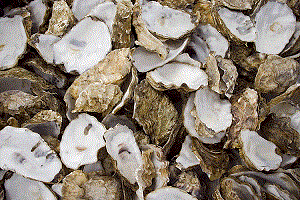 |
|
RESTAURANTS RECYCLE OYSTER SHELLS
Tourists won't see it, but Texas Parks and Wildlife Department officials hope a new oyster reef only a few feet from the Kemah boardwalk will have a large impact. Approximately 250 cubic yards�about 200 tons�of recycled oyster shell was dumped in about 8 feet of water just east of the Kemah Boardwalk.
"While this reef will never be harvested, it will provide ecological services and habitat for a variety of sea creatures," said Bryan Legare, a natural resource specialist with the Texas Parks and Wildlife Department. The reef, along with its accompanying signs and pamphlets, will teach visitors about a "more sustainable approach to the fishery." The local oystermen sell oysters to local restaurants. Restaurants can then work with the Galveston Bay Foundation to recycle the shells. Those shells are then used in restoration projects that provide habitat for oysters and other creatures. The alternative is that the shells can end up as construction material or in chicken feed.

For this project, the Misho Oyster Co. in San Leon provided the shells as well as the boat and labor. The shells were sprayed into the water with two water cannons. It's such an active and high profile area that it's a great opportunity to teach the masses about oyster reefs and their importance. Three restaurants on the Boardwalk have joined the oyster shell recycling program.
After being cured, the shell is used in the foundation's oyster gardening program. The foundation works with waterfront property owners in Seabrook, Kemah, Bacliff and San Leon to suspend bags of oyster shells in the water. Young oysters can attach to the shells and grow. At the end of summer, the new oysters growing in the bags will be placed over the new reef by the Boardwalk. Since the reef won't be harvested, it will help produce more young oysters, or spat, that can spread to other areas of the bay. Oysters and their reefs provide important ecological services. They filter water, protect the shoreline and control erosion. The reef will also provide important habitat not just for oysters, which need a hard substrate to attach to, but also for crabs and shrimp. That will eventually attract larger fish.
"There are all kinds of fishermen around here, and they are going to end up loving this," added Bryan.
Gonzalez, Christopher Smith, The Associated Press, "Restaurants
recycle shells for Galveston oyster reef," Fort Worth Star-Telegram, July 13, 2014
To learn more about GHA and how your property can be greener, jump to
Green Hotels Association!
or CALL 713/789-8889 TODAY!
|
|

GREEN QUOTE!
 "While this reef will never be harvested, it will provide ecological services and habitat for a variety of sea creatures," said Bryan Legare, a natural resource specialist with the Texas Parks and Wildlife Department."
"While this reef will never be harvested, it will provide ecological services and habitat for a variety of sea creatures," said Bryan Legare, a natural resource specialist with the Texas Parks and Wildlife Department."







greenhotels.com
|
|
Unique Visitors |
Hits |
| Jan |
8,223 |
378,113 |
| Feb |
8,124 |
378,460 |
| Mar |
9,904 |
451,836 |
| Apr |
10,639 |
464,092 |
| May |
9,848 |
416,078 |
| Jun |
11,776 |
373,910 |
| Jul |
N/A |
N/A |
| Aug |
N/A |
N/A |
| TOTAL 2014 |
58,514 |
2,462,489 |

|
 |



